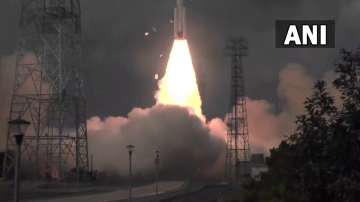PSLV-C54 launch: ISRO's ever reliable PSLV rocket once again proved its mettle on Saturday when the polar satellite launch vehicle placed an earth observation satellite and eight other co-passenger satellites in multiple orbits, in one of the longest missions.
PSLV-C54 successfully injected the earth observation satellite (Oceansat) and eight other customer satellites into sun-synchronous orbits, ISRO said.
"PSLV-C54/EOS-06 Mission is accomplished.The remaining satellites have all been injected into their intended orbits," it said in a tweet.
This was PSLV's 56th flight. The mission is said to be the fifth and last for the Bengaluru-headquartered space agency in 2022.
As the 25.30 hour countdown which began on Friday concluded the rocket lifted off at a pre-fixed time at 11.56 am today.
The 44.4 metre tall PSLV soared majestically into a bright forenoon sky, emanating bright orange fumes from its tail from the first launch pad at the Satish Dhawan Space Centre here, about 115 kms from Chennai.
ALSO READ: Vikram-S marks 'The Beginning' of private venture in Indian space programme with maiden success
After a flight of about 17 minutes, the rocket successfully placed the primary payload Earth Observation Satellite (Oceansat) at an altitude of about 742 km while the passenger satellites were placed sequentially after lowering the altitude of the rocket to about 528 km in the sun-synchronous orbits by the scientists.
Mission Director S R Biju said, "PSLV-C54 mission is successfully accomplished after a 2-hour flight duration."
The Earth Observation Satellite-6 is the third-generation satellite in the Oceansat series. This is to provide continuity services of Oceansat-2 spacecraft with enhanced payload specifications as well as application areas.
The mission objective is to ensure data continuity of ocean color and wind vector data to sustain the operational applications.
The customer payloads include ISRO Nano Satellite-2 for Bhutan (INS-2B) which would have two payloads namely NanoMx and APRS-Digipeater. NanoMx is a multispectral optical imaging payload developed by Space Applications Centre while APRS-Digipeater payload is jointly developed by Department of Information Technology and Telecom, Bhutan and U R Rao Satellite Centre, Bengaluru.
ALSO READ: Chandrayaan 3 set to launch in June 2023 with more robust rover
Another payload in the rocket is the 'Anand' satellite developed by Bengaluru headquartered space start-up, Pixxel which is a technology demonstrator to demonstrate the capabilities and commercial applications of miniaturized earth-observation camera for camera observation using a micro-satellite in Low Earth Orbit.
The 'Thybolt' (two satellites) is from another space start-up Dhruva Space while Astrocast is a technology demonstrator satellite for the internet of things as the payload from Spaceflight, the United States of America
